As a car owner, it’s important to know how to maintain your car’s engine to ensure its longevity and optimal performance. Regular maintenance can save you from costly repairs down the road and keep your car running smoothly for years to come.
From checking fluid levels to replacing spark plugs, there are many simple steps you can take to keep your engine in top shape. In this section, I will guide you through the essential tips and tricks for DIY car engine maintenance. Let’s get started!
Key Takeaways
- Regular engine maintenance is essential for the longevity and performance of your vehicle.
- Checking fluid levels, replacing spark plugs, and maintaining the cooling system are crucial tasks for engine maintenance.
- Keeping your engine clean and paying attention to unusual noises or vibrations can prevent major issues from developing.
- Establishing a regular maintenance schedule and keeping accurate documentation can help you stay on top of engine maintenance.
- Consult your vehicle’s owner’s manual for specific recommendations and seek professional help for major issues.
Regular Oil Changes and Filter Replacements
As a car owner, I understand the importance of regular engine maintenance to keep my vehicle running smoothly. One of the essential tasks for maintaining my car’s engine is ensuring regular oil changes and filter replacements. These routine tasks can prevent engine damage and extend the lifespan of my vehicle.
The Importance of Oil Changes
Oil is the lifeblood of a car’s engine, lubricating the moving parts, and preventing wear and tear. Over time, however, oil breaks down and becomes less effective, leading to engine damage. That’s where regular oil changes come in.
By changing the oil and oil filter at the recommended intervals, the engine stays lubricated and clean, ensuring optimal performance. The frequency of oil changes may vary depending on the type of oil used and the vehicle’s mileage. Consult the owner’s manual or a trusted mechanic for specific recommendations.
The Importance of Filter Replacements
The oil filter plays a crucial role in protecting the engine from contaminants, such as dirt and debris. Over time, the filter becomes clogged, reducing its effectiveness and potentially causing engine damage. Replacing the filter regularly is essential to ensure proper filtration and prevent engine damage.
Additionally, other filters in the car, such as air filters and fuel filters, should also be regularly checked and replaced as needed to maintain engine health.
Conclusion
Maintaining my car’s engine is necessary to keep my vehicle running smoothly and efficiently. Regular oil changes and filter replacements are crucial tasks that should not be neglected. By following the recommended maintenance schedule and consulting a trusted mechanic, I can ensure my engine remains in top condition for years to come.
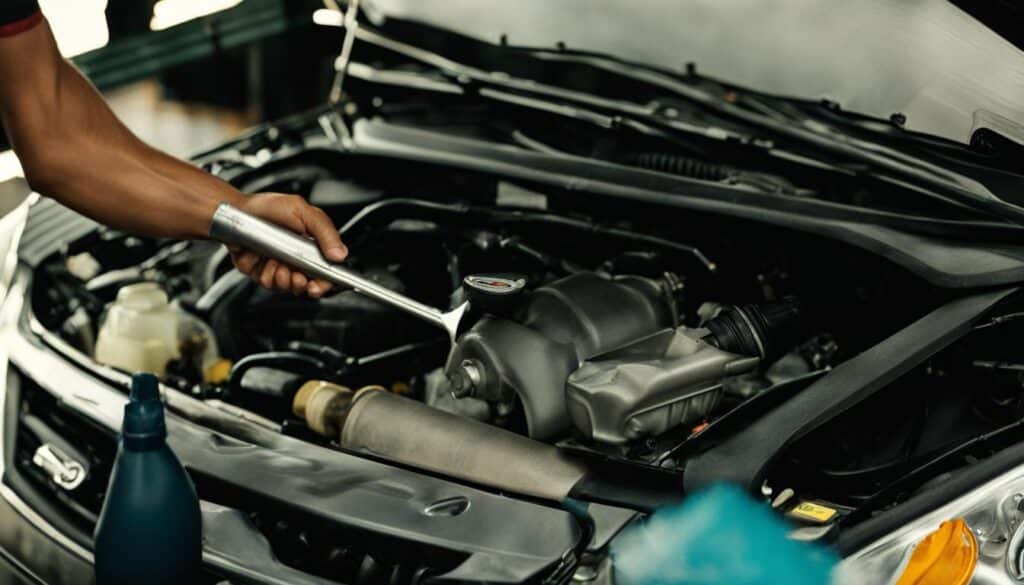
Monitoring Fluid Levels
Proper fluid levels are essential for the smooth operation of your car’s engine. Regularly checking and topping up fluids can help prevent potential engine damage and ensure optimal performance. In this section, I will discuss the various fluids that need to be monitored, how to check them, and when to top them up or replace them.
Engine Oil
Engine oil is the lifeblood of your engine, lubricating its moving parts and reducing friction and wear. Low oil levels can lead to engine overheating and eventual failure. To check your engine oil, park your car on level ground, wait for the engine to cool down, and remove the dipstick. Wipe it clean with a cloth, reinsert it, and remove it again. Check the level on the dipstick against the minimum and maximum marks. If the level is low, add more oil of the recommended type and viscosity. Consult your owner’s manual for how often to change the oil and what type of oil to use.
Car engine maintenance tip: Check your engine oil once a month or before long trips.
Coolant
Coolant, also known as antifreeze, is responsible for regulating your engine’s temperature and preventing it from overheating. Low coolant levels can cause your engine to overheat and potentially cause severe damage. To check your coolant levels, locate your car’s coolant reservoir, usually a transparent plastic tank near the radiator, and check the level against the markings on the side of the tank. If the level is low, top it up with the recommended type of coolant or distilled water if necessary. Avoid opening the radiator cap when the engine is hot, as this can cause serious burns or scalds.
Car engine maintenance tip: Check your coolant levels once a month or before long trips.
Brake Fluid
Brake fluid is responsible for transferring pressure from the brake pedal to the brake calipers, where the brakes are engaged. Low brake fluid levels can cause your brakes to fail, compromising your safety on the road. To check your brake fluid levels, locate the brake master cylinder, usually near the firewall at the back of the engine bay. Check the fluid level against the markings on the reservoir’s side. If the level is low, top it up with the recommended type of brake fluid.
Car engine maintenance tip: Check your brake fluid levels once a month or before long trips.
Power Steering Fluid
Power steering fluid helps you steer your car easily and smoothly, applying pressure to the steering system as you turn the wheel. Low power steering fluid levels can cause difficulty in steering, leading to potential accidents. To check your power steering fluid levels, locate the power steering reservoir, often near the engine’s front, and check the level against the markings on the side of the reservoir. If the level is low, top it up with the recommended type of power steering fluid.
Car engine maintenance tip: Check your power steering fluid levels once a month or before long trips.
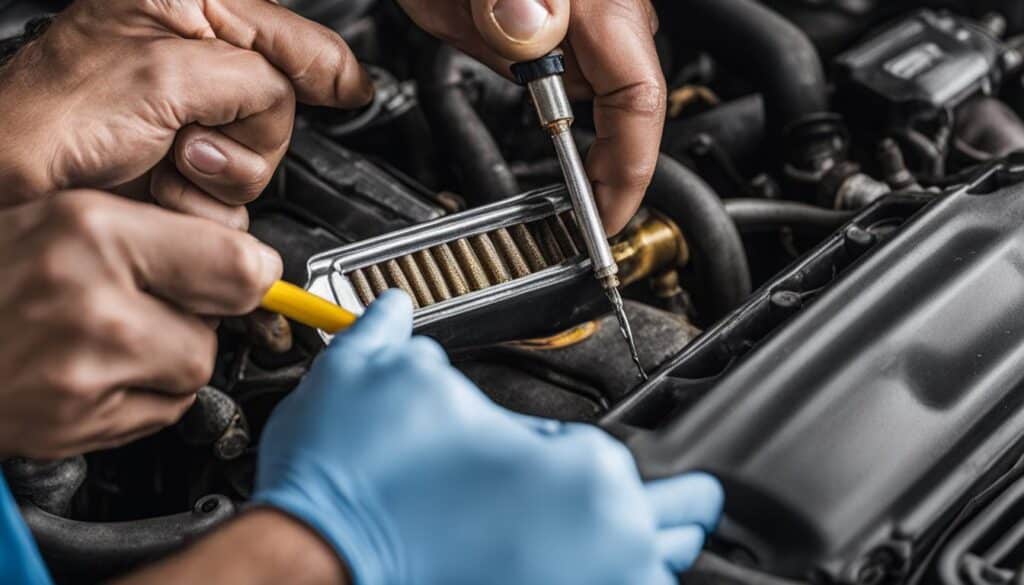
By regularly monitoring and topping up your car’s fluids, you can help keep your engine running smoothly and prevent potential damage. Refer to your owner’s manual for specific recommendations on checking and topping up fluids, and consult a professional if you encounter any issues.
Keeping the Cooling System in Check
Proper engine maintenance requires attention to the cooling system. The cooling system is responsible for preventing the engine from overheating, which can cause serious damage if left unchecked.
Regular inspections: To keep your cooling system in check, it’s important to perform regular inspections. Check for leaks or cracks in the hoses and belts. If these are found, they should be replaced immediately. Look for any signs of corrosion or rust on the radiator, and ensure that the coolant level is topped up to the manufacturer’s recommended level.
Coolant flushes: Over time, the coolant in your engine can become dirty and lose its effectiveness. To combat this, a coolant flush is recommended every 30,000 miles (50,000 km) or every 3 years, whichever comes first. During a coolant flush, all of the old coolant is drained out, and the system is flushed with clean water before new coolant is added.
Radiator maintenance: The radiator is a critical component of the cooling system. It’s responsible for transferring heat away from the engine and releasing it into the air. To maintain the radiator, it’s important to keep it clean and free of debris. Use a soft brush or compressed air to remove any dirt or dust that may be blocking the fins. Take care when cleaning the fins, as they can be delicate and easily damaged. Regular maintenance of the radiator will help to prevent overheating and ensure your engine runs smoothly.
By following these simple steps, you can ensure that your car’s cooling system is in good working condition and prevent potential engine damage. Don’t forget to consult your vehicle’s owner’s manual for specific recommendations on how often to perform these tasks.
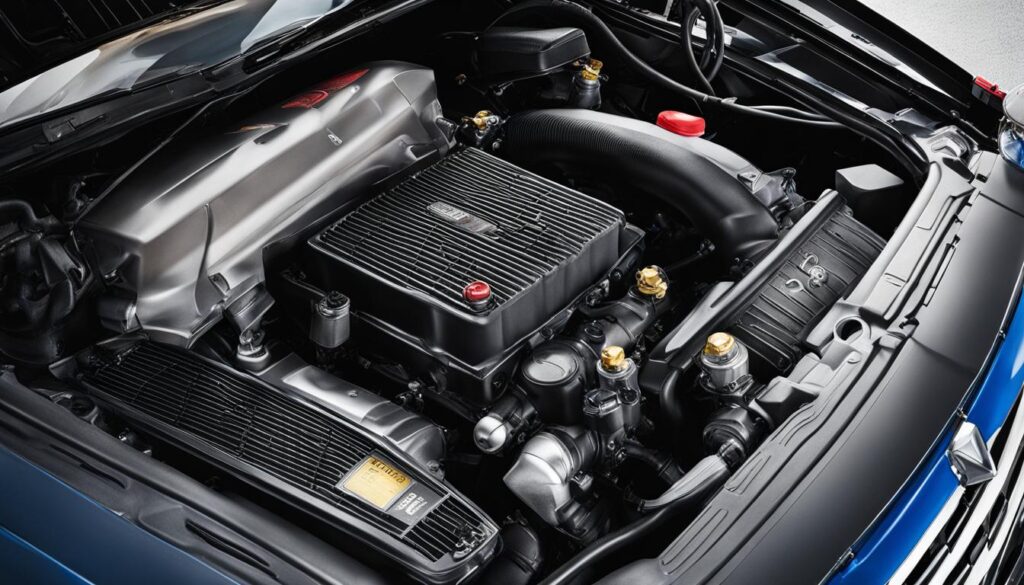
Maintaining the Belts and Hoses
Belts and hoses are essential engine components that connect various parts of the engine, such as the alternator, power steering pump, and water pump. Over time, they can wear out and cause significant damage to your engine if not addressed promptly.
Inspecting Belts
Inspect belts regularly for signs of damage, such as cracks, fraying, or glazing. Using a flashlight, check for any wear or tear and ensure they are tight and aligned. If you notice any of these issues, it’s time to replace the belt.
Replacing Belts
If you need to replace a belt, consult your car’s manual for the correct belt size and type. Additionally, you may need to remove other components to access the belt, so always follow the manual’s instructions carefully or seek professional assistance.
Checking Hoses
Hoses are responsible for carrying essential fluids, such as coolant, to various engine parts. Check hoses regularly for signs of wear or leakage, particularly around the clamps and connections. Replace any damaged or worn hoses immediately.
Replacing Hoses
When replacing hoses, ensure that the replacement hose is the correct size and type for your vehicle. When reinstalling the hose, make sure it is aligned correctly and properly clamped to prevent any leaks.
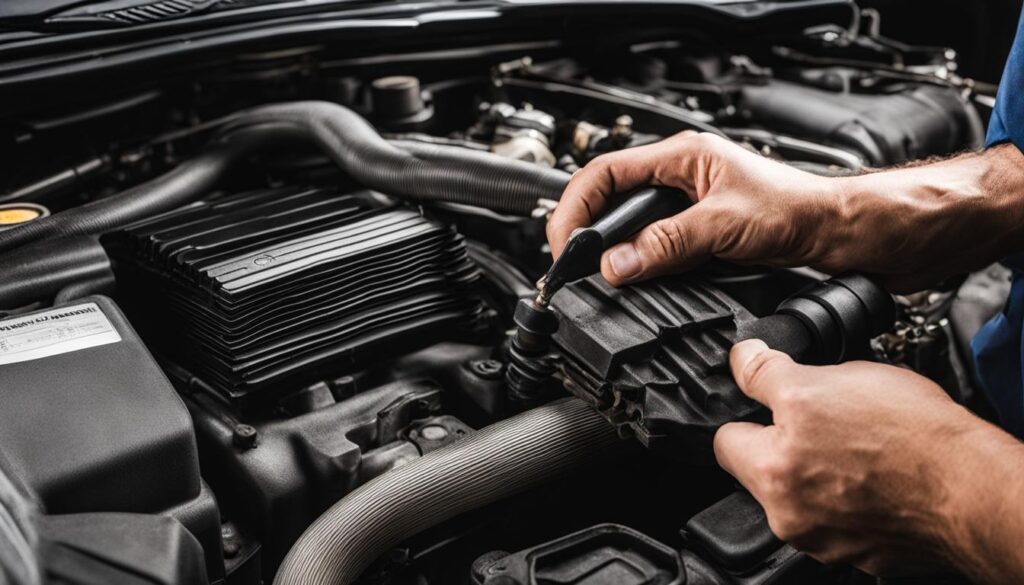
By regularly inspecting and maintaining your vehicle’s belts and hoses, you can prevent significant engine damage and prolong your car’s lifespan.
Checking and Replacing Spark Plugs
Spark plugs are a critical component of your car’s engine, responsible for igniting the fuel and air mixture necessary to power the vehicle. Over time, spark plugs can become worn or dirty, leading to engine misfires, decreased performance, and reduced fuel efficiency.
It’s essential to inspect and replace your spark plugs regularly to ensure that your engine is operating at its best. Most vehicles require spark plug replacement every 30,000 to 100,000 miles, depending on the make and model. Consult your owner’s manual for specific recommendations.
How to Inspect Spark Plugs
Inspecting your spark plugs is a relatively simple process that you can do yourself with a few basic tools, including a spark plug socket and a spark plug gap gauge.
- First, locate the spark plugs – they are typically found near the top of the engine, with wires or coils attached to them.
- Carefully remove one spark plug at a time using the spark plug socket. Be sure to keep the plugs in order to ensure that they are reinstalled correctly.
- Inspect the spark plug for signs of wear, including discoloration or cracking on the porcelain insulator and deposits on the electrodes. Use the spark plug gap gauge to check the gap between the electrodes – it should match the manufacturer’s specifications.
If you notice any obvious signs of wear or damage, it’s time to replace the spark plug. Even if the plug appears to be in good condition, it’s still a good idea to replace it if it has been in use for the recommended amount of miles.
How to Replace Spark Plugs
Replacing spark plugs is a simple DIY task that requires a few basic tools and some patience. Here are the general steps:
- Again, locate the spark plugs and remove the first one using the spark plug socket.
- Insert the new spark plug, being careful not to cross-thread it. Use the spark plug socket and torque wrench to tighten the plug to the manufacturer’s specifications.
- Repeat the process for each spark plug, being sure to install them in the correct order.
It’s also a good idea to replace the spark plug wires or coils when you change the spark plugs, as worn or damaged wires can cause misfires and other engine issues. Consult your owner’s manual or a mechanic for specific instructions.
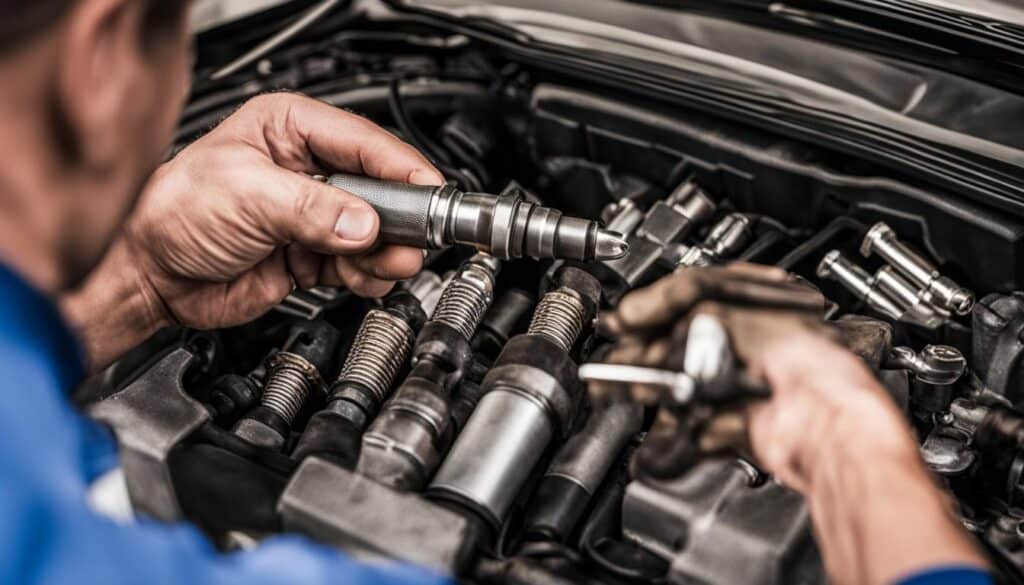
Regularly inspecting and replacing your spark plugs can help ensure optimal engine performance and fuel efficiency. If you’re unsure about how to inspect or replace your spark plugs, consult a mechanic or other professional for guidance.
Regular Battery Maintenance
Another important aspect of car engine maintenance is taking care of your battery. Not only does the battery provide the electrical power necessary to start your engine, but it also powers all the electrical components in your car. This means that ensuring its proper functioning is vital to the performance of your vehicle.
To maintain your car battery, there are a few simple tips that you can follow:
- Regularly check the battery terminals for any signs of corrosion or build-up. If you notice any, clean them off using a solution of baking soda and water.
- Check the voltage of your battery regularly using a voltmeter, especially during extreme weather conditions. If the voltage falls below 12.4 volts, it may be time to replace your battery.
- Ensure that your battery is securely fastened in its tray and that the connections are tight.
- If you are not planning to use your vehicle for an extended period, remove the battery and store it in a cool, dry place.
By following these simple steps, you can prolong the life of your battery and avoid any potential breakdowns or problems. Remember that regular maintenance is essential for the long-term health of your car’s engine.
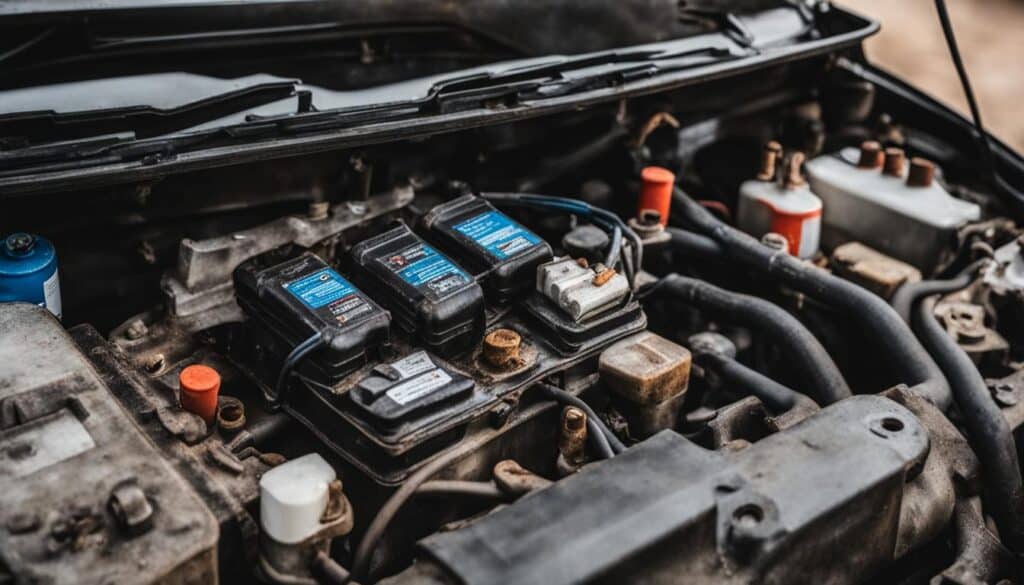
Keeping the Engine Clean
Keeping your car’s engine clean is crucial for its overall performance and longevity. A dirty engine can cause a variety of issues, including reduced fuel efficiency, overheating, and even engine failure. In this section, I will discuss the importance of engine cleaning and provide practical tips on how to do it safely and effectively.
One of the first steps in engine cleaning is to remove any debris or dirt on the engine’s surface. This can be done using a soft-bristled brush or a compressed air gun. Be sure to cover any sensitive electrical components with plastic to prevent damage from water or cleaning solutions.
Next, you can use a degreaser to remove any oil or grease buildup on the engine. Make sure to choose a degreaser that is safe for automotive use and follow the manufacturer’s instructions for application and dilution. Apply the degreaser to the engine’s surface and allow it to sit for a few minutes before scrubbing with a soft-bristled brush. Rinse the engine thoroughly with water, making sure to avoid any electrical components.
| Tip: | It’s a good idea to cover the battery and alternator with plastic bags to prevent water from getting into the components. |
|---|
After cleaning the engine, it’s important to dry it thoroughly. Use a clean, dry cloth to wipe down the engine’s surface and remove any excess water. You can also let the engine run for a few minutes to evaporate any remaining water.
Finally, you can apply an engine dressing to give your engine a shiny, like-new appearance. Engine dressings are available in aerosol or liquid form and can be applied using a clean cloth or spray bottle. Be sure to choose a dressing that is safe for automotive use and avoid applying it to any electrical components or areas that get hot.

Overall, keeping your car’s engine clean is an essential part of engine maintenance. By following these tips, you can help prevent engine damage and ensure optimal performance for years to come.
Paying Attention to Unusual Noises or Vibrations
It’s important to pay close attention to any unusual noises or vibrations coming from your car’s engine. These can be signs of potential problems that require immediate attention. If left unaddressed, these issues can lead to more significant damage and costly repairs down the line.
Some common engine noises include knocking, hissing, and screeching. If you hear any of these sounds, it’s crucial to identify the source and address it quickly. Additionally, if you feel any unusual vibrations or shaking while driving, this could be a warning sign of engine trouble.
When faced with unfamiliar noises or vibrations, it’s best to consult an experienced mechanic who can diagnose the issue and provide the appropriate solution. Ignoring these symptoms can result in serious engine damage and possible safety hazards.
Regular engine maintenance and care can reduce the likelihood of encountering these problems. By following the essential engine maintenance tips and using the engine maintenance checklist provided in this article, you can catch potential issues before they become costly repairs.

Pro tip: If you notice any unusual sounds or vibrations while driving, it’s best to pull over and turn off your engine immediately. Continuing to drive with these symptoms can cause further damage and pose a risk to your safety.
Regular Maintenance Schedule and Documentation
Establishing a regular maintenance schedule is essential for keeping your car’s engine in top condition. By following a set routine, you can catch potential issues early and avoid costly repairs down the line. Additionally, keeping accurate documentation of your engine maintenance activities will help ensure you stay on track and don’t miss any essential tasks.
When creating your maintenance schedule, refer to your vehicle’s owner’s manual for manufacturer recommendations. This will provide you with guidance on how often to perform specific tasks, such as oil changes, filter replacements, and inspections.
It’s also important to consider your driving habits and the conditions you typically drive in. For example, if you frequently drive in stop-and-go traffic or in hot weather, you may need to perform maintenance tasks more frequently than the manufacturer recommends.
When recording your maintenance activities, include the date, mileage, and a brief description of the task performed. This documentation will help you keep track of when specific tasks were completed and when they will need to be performed again.
By following a regular maintenance schedule and keeping accurate documentation, you can ensure your car’s engine receives the care and attention it needs to perform at its best. Remember to consult a professional if you encounter any major issues or have any concerns about your engine’s performance.
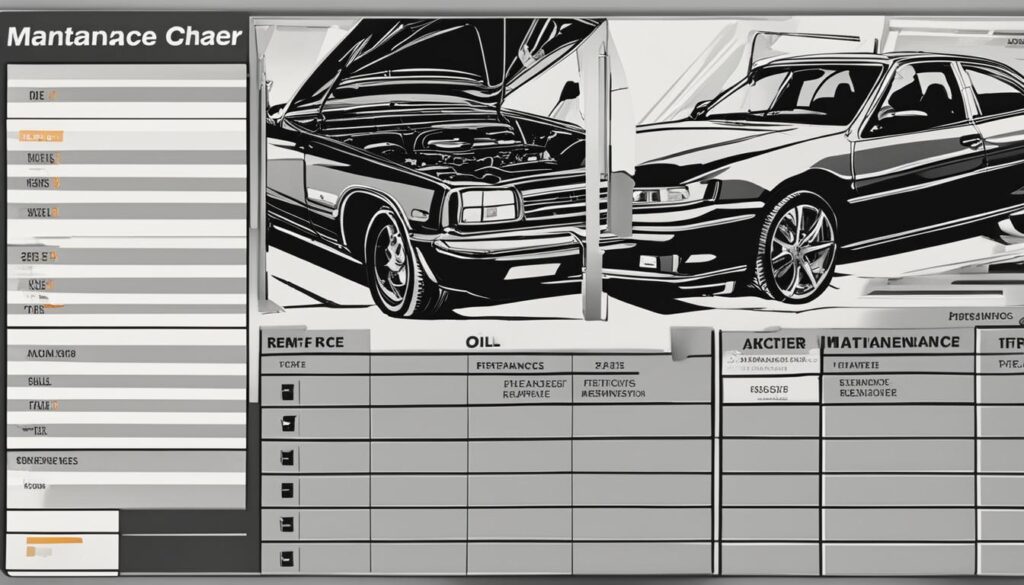
Conclusion
In conclusion, maintaining your car’s engine is essential for extending its lifespan and ensuring it continues to perform at its best. By following this engine maintenance guide, you now have a solid foundation for DIY car engine maintenance and keeping your vehicle in excellent condition. Remember, regular engine maintenance is key, and following an engine maintenance checklist will help you stay on top of all the necessary tasks.
Don’t forget to pay attention to any unusual noises or vibrations and promptly address them to prevent further damage. And keeping accurate documentation of your engine maintenance activities will help you stay organized and consistent in your efforts.
Thank you for reading this engine maintenance guide with engine maintenance tips and tricks. Hopefully, you have found it informative and helpful in maintaining your car’s engine. Remember always to refer to your vehicle’s owner’s manual for specific maintenance recommendations and seek professional help for more complex issues.
Take care of your car, and it will take care of you, providing reliable transportation for years to come.
FAQ
How often should I change my car’s oil and replace the filter?
It is generally recommended to change your car’s oil and replace the filter every 3,000 to 5,000 miles or as specified in your vehicle’s owner’s manual.
What fluids should I monitor in my car’s engine?
The fluids that should be monitored in your car’s engine include engine oil, coolant, brake fluid, power steering fluid, and transmission fluid.
How often should I check and top up the fluid levels in my car’s engine?
It is recommended to check the fluid levels in your car’s engine at least once a month and top them up as necessary. However, refer to your vehicle’s owner’s manual for specific recommendations.
How can I maintain the cooling system of my car’s engine?
To maintain the cooling system, regularly inspect the radiator, coolant levels, and hoses for any leaks or damage. Additionally, it is recommended to flush and replace the coolant as specified in your vehicle’s owner’s manual.
When should I inspect and replace the belts and hoses in my car’s engine?
Inspect the belts and hoses in your car’s engine regularly for any signs of wear, cracks, or leaks. Replace them if you notice any damage or as recommended by your vehicle’s manufacturer.
How often should I check and replace the spark plugs in my car’s engine?
It is generally recommended to inspect and clean the spark plugs every 30,000 miles and replace them every 60,000 to 100,000 miles or as specified by your vehicle’s manufacturer.
What maintenance tasks should I perform on my car’s battery?
Regular battery maintenance includes cleaning the terminals, checking the voltage, and ensuring a secure connection. It is also important to replace the battery when it shows signs of deterioration or as recommended by your vehicle’s manufacturer.
How can I keep my car’s engine clean?
To keep your car’s engine clean, regularly wash the exterior surface with a gentle automotive cleaner, avoid spraying water directly on electrical components, and remove any debris or leaves from the engine bay.
What should I do if I notice unusual noises or vibrations from my car’s engine?
If you notice unusual noises or vibrations, it is important to have your car’s engine inspected by a professional mechanic. Ignoring these signs can lead to further damage and potentially more expensive repairs.
How can I establish a regular maintenance schedule for my car’s engine?
To establish a regular maintenance schedule, consult your vehicle’s owner’s manual for recommended service intervals and create a calendar or reminder system to ensure timely maintenance tasks are performed.
Why is it important to maintain documentation of my car’s engine maintenance?
Maintaining documentation of your car’s engine maintenance helps you keep track of performed tasks, dates, and mileage. This information is valuable for warranty claims, resale value, and knowing when specific maintenance tasks are due.




